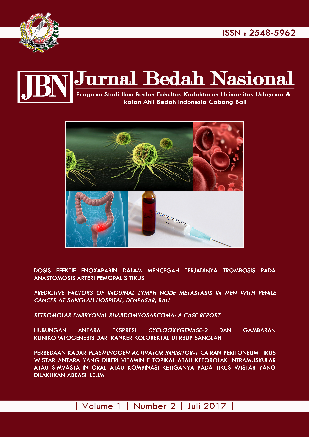Predictive Factors of Inguinal Lymph Node Metastasis in Men with Penile Cancer at Sanglah Hospital, Denpasar, Bali
Abstract
Objective: to know the predictive factors of inguinal lymph node metastasis in men with penile cancer. Methods: this was a retrospective study on 65 patients with penile cancer in Sanglah Hospital, Denpasar, Bali from 2011 to 2015. Patients were included in analysis if they had undergone partial or total penectomy, and inguinal lymph-node dissection or excisional biopsy. Inguinal lymph node metastasis was defined as tumor positive node based on histopathology finding in patients who underwent inguinal lymph node dissection or excisional biopsy. Data retrieved from this study was analyzed by Chi Square and Kruskal-Wallis test. Results: a total of 65 patients diagnosed as penile cancer in Sanglah Hospital, Denpasar, Bali from 2011 to 2015. Mean age of these patients was 53.24 ± 13.42 years. The youngest age was 27 years old and the oldest was 86 years old. Fifteen patients were excluded for different reasons, remaining 50 patients for further analysis. From 50 patients included in analysis, 25 patient (50%) had inguinal lymph node metastasis. There were significant correlation between pathologic stage of the primary tumor (p=0.021), histologic grade (p=0.020), and vascular invasion (p=0.008) with the presence of inguinal lymph node metastasis. Based on pathologic stage of the primary tumor, only 1 of 7 patients (14%) with pT1 had inguinal lymph node metastasis compared with 10 of 24 patients (42%) with pT2, 10 of 15 patients (67%) with pT3, and 4 of 4 patients with pT4 (100%). Based on histologic grade, only 2 of 9 patients (22%) with grade I had inguinal lymph node metastasis compared with 18 of 36 patients (50%) with grade II, and 5 of 5 patients (100%) with grade III. Based on vascular invasion, only 15 of 38 patients (39%) without vascular invasion had inguinal lymph node metastasis compared with 10 of 12 patients (83%) with vascular invasion. No significant correlation was found between age and the presence of inguinal lymph node metastasis (p=0.829). Conclusion: pathologic stage of the primary tumor, histologic grade, and vascular invasion were predictive factors of inguinal lymph node metastasis in men with penile cancer.
Downloads
Program Studi Ilmu Bedah Fakultas Kedokteran Universitas Udayana. 
This work is licensed under a Creative Commons Attribution 4.0 International License.






